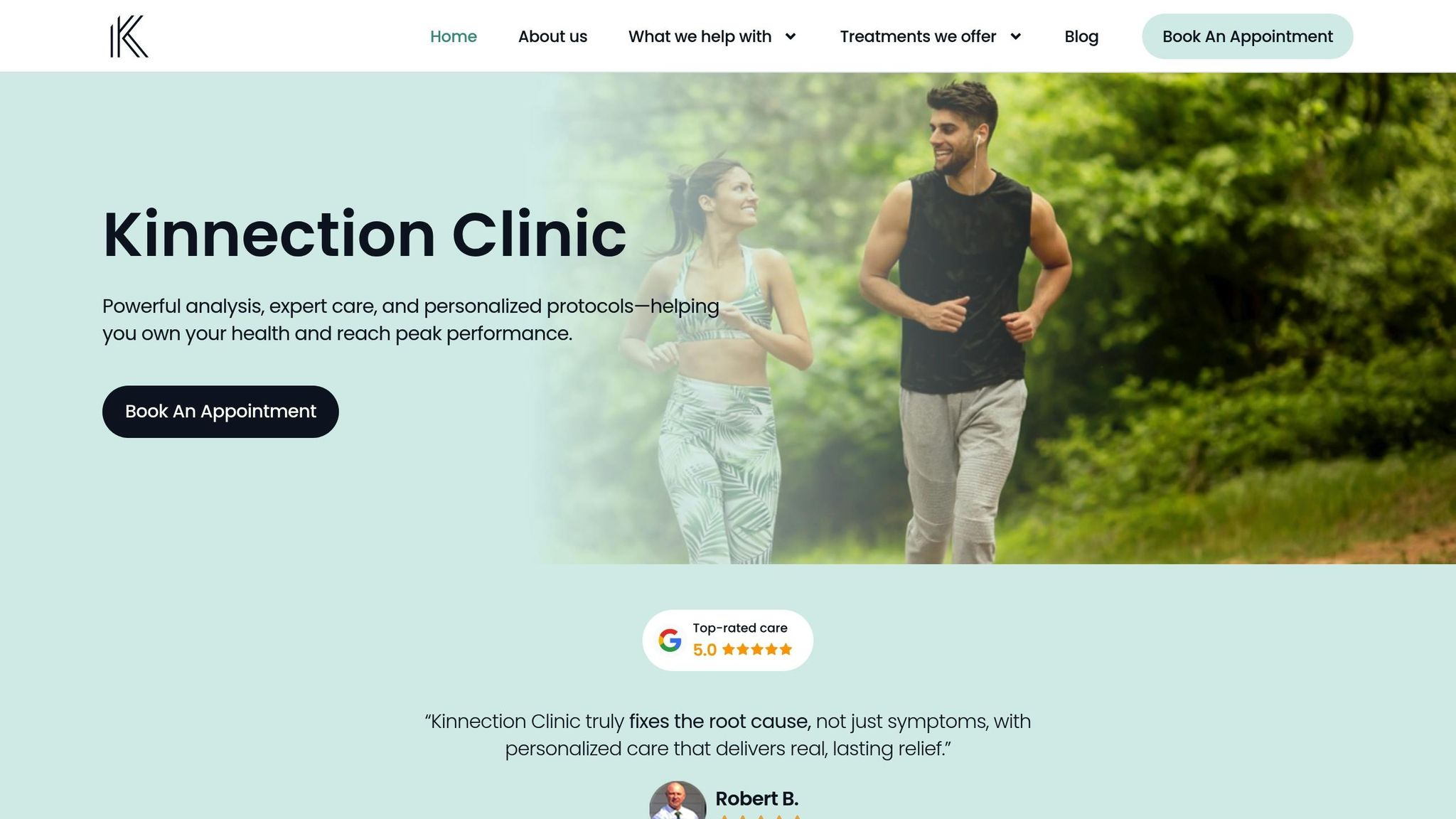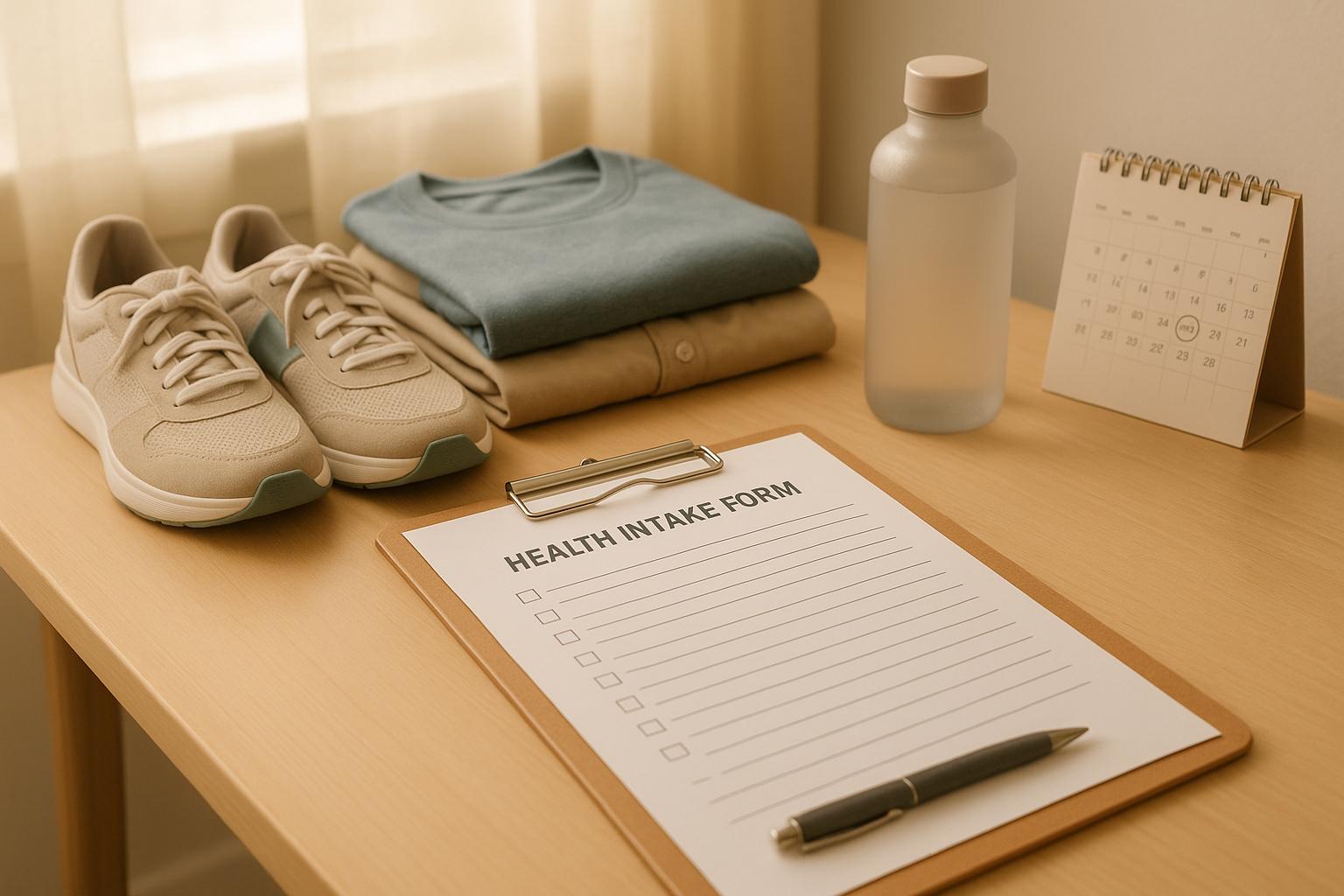Heading to a chiropractor for the first time? Here’s a quick rundown of what you need to know before your appointment:
- What to Bring:
- ID and Insurance: Bring a photo ID and your insurance card.
- Medical Records: Include past imaging (X-rays, MRIs) and a list of medications/allergies.
- Completed Intake Forms: Fill these out beforehand if possible.
- What to Wear:
- Opt for loose, comfortable clothing (e.g., yoga pants, T-shirts).
- Avoid restrictive outfits, bulky coats, or excessive jewelry.
- Wear supportive shoes; skip high heels or flip-flops.
- What to Expect:
- Examination: A detailed 5-point exam (visual checks, palpation, X-rays, etc.) to locate spinal issues.
- Adjustments: Precise manual movements targeting specific misalignments. You may hear joint "cracks", which are normal.
- Questions to Ask:
- How does the Gonstead method work for your condition?
- What tools and techniques will be used?
- What aftercare steps are recommended?
- Tips for a Smooth Visit:
- Arrive 10–15 minutes early.
- Stay hydrated and avoid heavy meals before the session.
- Bring a small bag with essentials like a water bottle or light sweater.
5 Things to Expect on Your First Chiropractic Visit
Required Documents to Bring
Getting your paperwork in order before your visit can speed up the check-in process and give your chiropractor the details they need to customize your care.
ID and Insurance Information
Make sure to bring a valid photo ID, like a driver’s license, state ID, or passport, to confirm your identity during check-in. Don’t forget your insurance card or relevant insurance details so the clinic can verify your coverage.
"For your first visit, the most important thing is to complete your intake forms prior to arriving to the office, so the doctor can review them. In addition, bring your ID and your insurance card (or claim number, etc. if you were involved in a car accident)."
If your visit stems from a car accident, additional documents like the police report, claim number, or your attorney’s contact information may also be required.
Next, gather your medical records and any imaging results for review.
Medical Records and Previous Imaging
Bring any relevant medical records from your primary care doctor, specialists, or previous chiropractors. A comprehensive health history gives your chiropractor a full picture of your condition.
If you have imaging results, such as X-rays, MRIs, or CT scans, bring those along – especially if they relate to the area causing pain. These images can help avoid unnecessary repeat tests and provide valuable insights into your condition.
You can also coordinate with your primary care physician to send your records directly to Kinnection Clinic. This ensures no important details are missed.
Don’t overlook your medication and allergy information. Prepare a complete list of your current prescriptions, supplements, and any known allergies, including over-the-counter products. This information might play a key role in shaping your treatment plan.
Lastly, complete your intake forms ahead of time for a seamless check-in experience.
Kinnection Clinic Intake Forms

Whenever possible, fill out your intake forms before arriving at the clinic. This gives you time to provide accurate, thoughtful answers without feeling rushed. These forms gather essential information, including personal details, medical history, insurance, lifestyle habits, and the reasons for your visit.
Digital forms make this process even easier. Studies show that 60% of healthcare consumers value the convenience of booking appointments, while 45% appreciate a smooth intake process. Kinnection Clinic’s digital forms allow you to complete everything at home, saving time and reducing stress.
Be thorough when filling out your forms. Include details about when your symptoms started, what worsens or improves them, and how they affect your daily life. This information helps Dr. Lars Gunnar prepare targeted questions and create a preliminary treatment plan tailored to your specific needs.
What to Wear and What to Bring
When preparing for your Gonstead chiropractic session, comfort and practicality are key. Choose clothing and items that allow for ease of movement and enhance your overall experience.
Clothing Guidelines
For your visit, loose and comfortable clothing is ideal. Athletic wear like yoga pants, leggings, sweatpants, or athletic shorts paired with a T-shirt, tank top, or light sweatshirt works well. These options allow for unrestricted movement and make adjustments easier for your chiropractor.
Avoid wearing restrictive clothing such as tight jeans, pencil skirts, or fitted dresses, as these can limit your range of motion. Similarly, skip heavy jackets or bulky coats, as they may interfere with the adjustment process.
If you’re someone who gets cold easily, consider breathable, moisture-wicking fabrics and bring a light layer, like a sweater. Treatment rooms are often kept cool for comfort during sessions.
Supportive footwear is another important consideration. Sneakers or flat shoes offer stability and are easy to remove if needed. Steer clear of high heels or flip-flops, which can be impractical.
Lastly, keep jewelry minimal. Large, dangling pieces or wide belts can get in the way during adjustments. If you have long hair, bring a hair tie to secure it for added comfort.
Personal Items to Consider
To make the most of your session, pack a few essentials:
- Water bottle: Staying hydrated before and after your session supports your body’s response to treatment and aids recovery.
- Comfort items: A small towel or face cover can add a touch of comfort during adjustments.
- Post-session essentials: Consider bringing facial wipes and a small brush to freshen up. A light sweater can also come in handy if you feel chilly after your session.
- Compact bag: Keep your belongings in a small bag to maintain a clutter-free space.
- Relaxation aids: If medical appointments make you anxious, bring headphones to listen to calming music or a stress ball to help you relax during wait times.
Some chiropractic offices offer gowns for adjustments, but arriving in suitable clothing ensures a more seamless experience. If you’re unsure about what to wear or bring, feel free to contact Kinnection Clinic ahead of time – they can provide tailored advice based on your treatment plan.
Questions to Ask Your Chiropractor
When visiting a Gonstead chiropractor, asking the right questions can help you understand your treatment plan and set realistic expectations. The Gonstead method stands out from other chiropractic techniques, so learning about its unique features will ensure you get the most from your care.
Gonstead Method and Treatment Goals
Begin by asking how the Gonstead technique is tailored to your specific condition. Request a clear explanation of what sets this method apart. For instance, it relies on five precise diagnostic criteria to assess your spine comprehensively, identifying the root cause of your discomfort rather than just addressing symptoms.
You might also want to know how the targeted adjustments work. Unlike generalized manipulations, Gonstead adjustments are precise and aim to correct specific spinal misalignments. Ask how this approach addresses conditions like sciatica, back pain, or headaches. Additionally, inquire about the expected timeline for results, as this will depend on your condition’s severity and the extent of your spinal misalignments.
Understanding the tools and techniques used in the Gonstead method is another key aspect of your visit.
Equipment and Adjustment Plans
The Gonstead method often involves specialized equipment designed for precision. Ask your chiropractor about tools like the cervical chair and knee-chest table, which help position your body for optimal adjustments. Another key instrument is the Nervoscope, which measures temperature changes along your spine to detect inflammation.
It’s also helpful to learn about the adjustment techniques themselves. Gonstead adjustments are performed manually, focusing on specific spinal segments rather than using tools like drop tables or activators. Be sure to ask how many sessions you might need and what each session will involve, as your treatment plan will be based on a detailed analysis of your condition.
Finally, understanding what to do after your appointment is just as important as the treatment itself.
After-Visit Care and Follow-Up Schedule
To maximize the benefits of your adjustments, ask your chiropractor about post-treatment care. For the first 24–48 hours, it’s important to know which activities to avoid and how to support your recovery through proper hydration, movement, and posture.
You should also inquire about any potential side effects. Some patients experience mild soreness after adjustments, and it’s helpful to know what to expect. Discuss your follow-up schedule, as regular adjustments are key to maintaining proper spinal alignment. Don’t forget to ask for home care advice, such as recommended stretches, posture tips, and whether to use ice or heat for any discomfort.
Lastly, talk about long-term maintenance care. Even after your initial symptoms subside, periodic Gonstead adjustments can help prevent future issues and support ongoing spinal health. By staying informed, you’ll be better equipped to make the most of your chiropractic care.
sbb-itb-d9e542d
What Happens During a Gonstead Chiropractic Session
Knowing what to expect during a Gonstead chiropractic session can make the experience more comfortable and reassuring. This specialized approach focuses on identifying and addressing the root cause of spinal issues, offering a detailed understanding of your spinal health. Here’s how the 5-point examination helps pinpoint the areas that need attention.
5-Point Gonstead Examination
During your session, the chiropractor will conduct a thorough 5-point examination to assess your spine and locate any subluxations:
- Visualization: From the moment you step in, your chiropractor observes your posture, gait, and movements. They look for irregularities in your ears, shoulders, and hips to identify potential misalignments.
- Instrumentation: Tools like a Nervoscope or Delta-T are used to measure skin temperature variations along your spine. These small changes can signal inflammation or nerve interference.
- Palpation: The chiropractor feels along your spine, both in motion and at rest, to detect changes in muscle tone, swelling, or abnormal contours.
- X-Ray Analysis: Full-spine X-rays, taken from both front and side views, provide a detailed look at your spinal structure. These images help locate misalignments and rule out other possible issues.
- Case Management: Your symptoms, including pain patterns and any functional problems, are carefully reviewed to determine which areas need adjustment.
"utilizes several methods of examination to analyze multiple factors, which, as effectively as possible, uncovers the primary characteristics of intervertebral disc lesions, intervertebral and full spine and pelvis alignment, as well as neurological ramifications of vertebral subluxation and full body health."
Session Steps and Adjustment Process
After completing the exam, your chiropractor will explain their findings and outline a personalized treatment plan. Adjustments involve precise manual manipulations of your spine or other joints. These movements aim to reduce nervous system interference and enhance your range of motion. You might feel some pressure and hear a cracking sound – this is the natural release of gas from your joints. Gonstead adjustments are tailored to the specific problem areas identified during the examination, ensuring targeted and personalized care. It’s normal to experience slight soreness afterward as your body begins its healing process.
Professional Care and Patient Focus
At Kinnection Clinic, your well-being is the top priority. Dr. Lars Gunnar and his team are dedicated to providing care in a private, comfortable environment, ensuring clear communication at every step of your treatment. They also offer detailed post-treatment guidance to support your recovery.
Your chiropractor will design a treatment plan based on your spinal analysis and individual health needs. Beyond the adjustment itself, you’ll receive advice on post-treatment care, such as avoiding certain activities for the first 24–48 hours, staying hydrated, and maintaining proper nutrition. This comprehensive approach ensures your recovery doesn’t stop at the clinic, offering ongoing wellness support and open communication about your progress and goals.
Common Concerns and Myths About Chiropractic Care
Chiropractic care often faces a host of misconceptions that can create unnecessary anxiety and even prevent people from seeking treatment. When it comes to the Gonstead technique, understanding the facts can help ease concerns and build trust. Let’s tackle some common myths and explore the safety and comfort of Gonstead adjustments.
Safety of Gonstead Adjustments
The Gonstead technique is widely regarded as one of the safest chiropractic methods. It relies on precise, carefully targeted movements that minimize risks while maximizing effectiveness.
"The Gonstead technique stands out as one of the safest and most effective adjusting methods, particularly suitable for children, pregnant women, and the elderly." – Duncan Chiropractic Group
Chiropractic care, in general, has an excellent safety record. For example, the risk of serious complications, such as one death per 1,000,000 neck manipulations, is significantly lower compared to the risks associated with NSAIDs, which account for 153 stroke deaths per 1,000,000 users.
This technique is designed to accommodate patients of all ages, from children to pregnant women and older adults, ensuring a tailored approach for every stage of life.
Pain and Comfort During Adjustments
A common concern is that chiropractic adjustments might be painful. However, the Gonstead technique is known for its focus on precision, which often alleviates discomfort rather than causing it. By addressing specific spinal misalignments, the adjustments typically result in significant relief.
"Chiropractic adjustments, including those in the Gonstead method, are generally not painful. The technique focuses on precise adjustments to correct spinal misalignments, which can result in relief from pain and discomfort. Chiropractors are trained to ensure adjustments are comfortable and tailored to each patient’s tolerance level." – FamilyChiro.com
What makes Gonstead adjustments unique is their precision. By targeting only the problematic areas of the spine without impacting surrounding segments, this method ensures a comfortable and effective experience.
Misunderstandings about chiropractic care – like the belief that it requires lifelong treatment, only addresses back pain, or can become "addictive" – are unfounded. Gonstead care is always tailored to your specific condition, addressing a variety of issues to improve alignment and overall health. With these clarifications, you can approach your session with confidence and ease.
Conclusion: Being Ready for Your Visit
Getting ready for your Gonstead visit is key to making the most of your treatment and ensuring that Dr. Lars Gunnar can provide care tailored to your needs.
Before your appointment, gather any necessary items like medical records, your insurance information, and a valid ID. Staying hydrated is also important – aim to drink at least 8 glasses of water beforehand to help support your spinal health. On the day of your visit, wear loose, comfortable clothing, show up 10–15 minutes early to complete any remaining paperwork, and have a light snack if needed, but steer clear of heavy meals within two hours of your session.
It’s also helpful to jot down a few questions or specific details about your symptoms. This helps create a clear and productive conversation with Dr. Lars Gunnar, ensuring that your concerns are addressed.
FAQs
What makes the Gonstead chiropractic method stand out?
The Gonstead chiropractic method stands out for its focus on pinpointing the root cause of discomfort. By addressing the specific issues causing pain, this technique enables precise adjustments that help restore proper joint motion and support nervous system function. The result? Less pain, better mobility, and improved overall well-being.
What makes Gonstead unique is its commitment to accuracy and safety. Each adjustment is carefully evaluated and customized to meet the individual’s needs. This personalized approach ensures a thorough and attentive experience, making it a trusted option for those looking for dependable spinal care.
What should I bring to my chiropractic appointment to ensure the chiropractor has all the necessary information?
To ensure your chiropractor can perform a comprehensive evaluation, bring along your most recent medical records and any pertinent imaging results, like X-rays or MRIs. Organize these documents neatly and include original or certified copies of imaging reports, lab tests, and notes from prior medical or chiropractic visits.
Being prepared with clearly labeled documents allows your chiropractor to efficiently review your history and develop a treatment plan tailored specifically to your needs.
What should I do if I feel sore or uncomfortable after a chiropractic adjustment?
It’s completely normal to feel a bit sore or uncomfortable after a chiropractic adjustment – your body is simply adapting to the changes. To help manage this, try placing an ice pack on the area for about 10–15 minutes. Staying hydrated and getting plenty of rest can also make a big difference. If you’re feeling stiff, gentle stretches or light movement might help loosen things up.
Over-the-counter pain relievers can be an option if needed, but most discomfort usually fades within 24–48 hours. Applying moist heat can also provide relief for tight muscles. Keep in mind, these adjustments are part of your body’s natural healing process, and drinking plenty of water can support your recovery even further.



